+ Open data
Open data
- Basic information
Basic information
| Entry | Database: PDB / ID: 7awa | |||||||||||||||
|---|---|---|---|---|---|---|---|---|---|---|---|---|---|---|---|---|
| Title | SctV (SsaV) cytoplasmic domain | |||||||||||||||
 Components Components | Secretion system apparatus protein SsaV | |||||||||||||||
 Keywords Keywords | PROTEIN TRANSPORT / Type III secretion / T3SS / Export Apparatus | |||||||||||||||
| Function / homology |  Function and homology information Function and homology information | |||||||||||||||
| Biological species |  Salmonella typhimurium (bacteria) Salmonella typhimurium (bacteria) | |||||||||||||||
| Method | ELECTRON MICROSCOPY / single particle reconstruction / cryo EM / Resolution: 3.5 Å | |||||||||||||||
 Authors Authors | Matthews-Palmer, T.R.S. / Gonzalez-Rodriguez, N. / Calcraft, T. / Lagercrantz, S. / Zachs, T. / Yu, X.J. / Grabe, G. / Holden, D. / Nans, A. / Rosenthal, P. ...Matthews-Palmer, T.R.S. / Gonzalez-Rodriguez, N. / Calcraft, T. / Lagercrantz, S. / Zachs, T. / Yu, X.J. / Grabe, G. / Holden, D. / Nans, A. / Rosenthal, P. / Rouse, S. / Beeby, M. | |||||||||||||||
| Funding support |  United Kingdom, 4items United Kingdom, 4items
| |||||||||||||||
 Citation Citation |  Journal: J Struct Biol / Year: 2021 Journal: J Struct Biol / Year: 2021Title: Structure of the cytoplasmic domain of SctV (SsaV) from the Salmonella SPI-2 injectisome and implications for a pH sensing mechanism. Authors: Teige R S Matthews-Palmer / Nayim Gonzalez-Rodriguez / Thomas Calcraft / Signe Lagercrantz / Tobias Zachs / Xiu-Jun Yu / Grzegorz J Grabe / David W Holden / Andrea Nans / Peter B Rosenthal / ...Authors: Teige R S Matthews-Palmer / Nayim Gonzalez-Rodriguez / Thomas Calcraft / Signe Lagercrantz / Tobias Zachs / Xiu-Jun Yu / Grzegorz J Grabe / David W Holden / Andrea Nans / Peter B Rosenthal / Sarah L Rouse / Morgan Beeby /  Abstract: Bacterial type III secretion systems assemble the axial structures of both injectisomes and flagella. Injectisome type III secretion systems subsequently secrete effector proteins through their ...Bacterial type III secretion systems assemble the axial structures of both injectisomes and flagella. Injectisome type III secretion systems subsequently secrete effector proteins through their hollow needle into a host, requiring co-ordination. In the Salmonella enterica serovar Typhimurium SPI-2 injectisome, this switch is triggered by sensing the neutral pH of the host cytoplasm. Central to specificity switching is a nonameric SctV protein with an N-terminal transmembrane domain and a toroidal C-terminal cytoplasmic domain. A 'gatekeeper' complex interacts with the SctV cytoplasmic domain in a pH dependent manner, facilitating translocon secretion while repressing effector secretion through a poorly understood mechanism. To better understand the role of SctV in SPI-2 translocon-effector specificity switching, we purified full-length SctV and determined its toroidal cytoplasmic region's structure using cryo-EM. Structural comparisons and molecular dynamics simulations revealed that the cytoplasmic torus is stabilized by its core subdomain 3, about which subdomains 2 and 4 hinge, varying the flexible outside cleft implicated in gatekeeper and substrate binding. In light of patterns of surface conservation, deprotonation, and structural motion, the location of previously identified critical residues suggest that gatekeeper binds a cleft buried between neighboring subdomain 4s. Simulations suggest that a local pH change from 5 to 7.2 stabilizes the subdomain 3 hinge and narrows the central aperture of the nonameric torus. Our results are consistent with a model of local pH sensing at SctV, where pH-dependent dynamics of SctV cytoplasmic domain affect binding of gatekeeper complex. | |||||||||||||||
| History |
|
- Structure visualization
Structure visualization
| Movie |
 Movie viewer Movie viewer |
|---|---|
| Structure viewer | Molecule:  Molmil Molmil Jmol/JSmol Jmol/JSmol |
- Downloads & links
Downloads & links
- Download
Download
| PDBx/mmCIF format |  7awa.cif.gz 7awa.cif.gz | 127.9 KB | Display |  PDBx/mmCIF format PDBx/mmCIF format |
|---|---|---|---|---|
| PDB format |  pdb7awa.ent.gz pdb7awa.ent.gz | 96.9 KB | Display |  PDB format PDB format |
| PDBx/mmJSON format |  7awa.json.gz 7awa.json.gz | Tree view |  PDBx/mmJSON format PDBx/mmJSON format | |
| Others |  Other downloads Other downloads |
-Validation report
| Summary document |  7awa_validation.pdf.gz 7awa_validation.pdf.gz | 725 KB | Display |  wwPDB validaton report wwPDB validaton report |
|---|---|---|---|---|
| Full document |  7awa_full_validation.pdf.gz 7awa_full_validation.pdf.gz | 728.1 KB | Display | |
| Data in XML |  7awa_validation.xml.gz 7awa_validation.xml.gz | 22 KB | Display | |
| Data in CIF |  7awa_validation.cif.gz 7awa_validation.cif.gz | 30.9 KB | Display | |
| Arichive directory |  https://data.pdbj.org/pub/pdb/validation_reports/aw/7awa https://data.pdbj.org/pub/pdb/validation_reports/aw/7awa ftp://data.pdbj.org/pub/pdb/validation_reports/aw/7awa ftp://data.pdbj.org/pub/pdb/validation_reports/aw/7awa | HTTPS FTP |
-Related structure data
| Related structure data |  11928MC M: map data used to model this data C: citing same article ( |
|---|---|
| Similar structure data |
- Links
Links
- Assembly
Assembly
| Deposited unit | 
|
|---|---|
| 1 |
|
- Components
Components
| #1: Protein | Mass: 76221.359 Da / Num. of mol.: 1 Source method: isolated from a genetically manipulated source Source: (gene. exp.)  Salmonella typhimurium (strain LT2 / SGSC1412 / ATCC 700720) (bacteria) Salmonella typhimurium (strain LT2 / SGSC1412 / ATCC 700720) (bacteria)Strain: LT2 / SGSC1412 / ATCC 700720 / Gene: ssaV, STM1414 / Plasmid: pQlinkN / Details (production host): pQlinkN-t5-ssaV6his-ampR / Production host:  |
|---|
-Experimental details
-Experiment
| Experiment | Method: ELECTRON MICROSCOPY |
|---|---|
| EM experiment | Aggregation state: PARTICLE / 3D reconstruction method: single particle reconstruction |
- Sample preparation
Sample preparation
| Component | Name: Homo-nonameric ring complex of SsaV (SctV) type III secretion system export apparatus protein. Type: ORGANELLE OR CELLULAR COMPONENT Details: Full length protein including transmembrane domain recombinantly expressed in E.coli C41 and extracted from membrane fraction with detergent DDM. Transmembrane domain present but not resolved. Entity ID: all / Source: RECOMBINANT | |||||||||||||||||||||||||
|---|---|---|---|---|---|---|---|---|---|---|---|---|---|---|---|---|---|---|---|---|---|---|---|---|---|---|
| Molecular weight | Value: 0.68 MDa / Experimental value: YES | |||||||||||||||||||||||||
| Source (natural) | Organism:  Salmonella enterica (bacteria) / Strain: LT2 Salmonella enterica (bacteria) / Strain: LT2 | |||||||||||||||||||||||||
| Source (recombinant) | Organism:  | |||||||||||||||||||||||||
| Buffer solution | pH: 8 | |||||||||||||||||||||||||
| Buffer component |
| |||||||||||||||||||||||||
| Specimen | Conc.: 1 mg/ml / Embedding applied: NO / Shadowing applied: NO / Staining applied: NO / Vitrification applied: YES Details: Sample was monodisperse on a continuous carbon film. | |||||||||||||||||||||||||
| Specimen support | Grid material: COPPER / Grid mesh size: 200 divisions/in. / Grid type: Quantifoil R2/2 | |||||||||||||||||||||||||
| Vitrification | Instrument: FEI VITROBOT MARK IV / Cryogen name: ETHANE-PROPANE / Humidity: 100 % / Chamber temperature: 277 K / Details: blot 2.5s |
- Electron microscopy imaging
Electron microscopy imaging
| Experimental equipment |  Model: Titan Krios / Image courtesy: FEI Company |
|---|---|
| Microscopy | Model: TFS KRIOS |
| Electron gun | Electron source:  FIELD EMISSION GUN / Accelerating voltage: 300 kV / Illumination mode: FLOOD BEAM FIELD EMISSION GUN / Accelerating voltage: 300 kV / Illumination mode: FLOOD BEAM |
| Electron lens | Mode: BRIGHT FIELD |
| Specimen holder | Cryogen: NITROGEN |
| Image recording | Average exposure time: 12 sec. / Electron dose: 70 e/Å2 / Detector mode: COUNTING / Film or detector model: GATAN K2 SUMMIT (4k x 4k) / Num. of grids imaged: 2 / Num. of real images: 6729 |
| EM imaging optics | Energyfilter name: GIF Bioquantum / Energyfilter slit width: 20 eV |
| Image scans | Movie frames/image: 40 |
- Processing
Processing
| EM software |
| ||||||||||||||||||||||||||||||||||||||||
|---|---|---|---|---|---|---|---|---|---|---|---|---|---|---|---|---|---|---|---|---|---|---|---|---|---|---|---|---|---|---|---|---|---|---|---|---|---|---|---|---|---|
| CTF correction | Type: PHASE FLIPPING AND AMPLITUDE CORRECTION | ||||||||||||||||||||||||||||||||||||||||
| Particle selection | Num. of particles selected: 988000 Details: interactive training particle picker in Xmipp, used in the Scipion wrapper | ||||||||||||||||||||||||||||||||||||||||
| Symmetry | Point symmetry: C9 (9 fold cyclic) | ||||||||||||||||||||||||||||||||||||||||
| 3D reconstruction | Resolution: 3.5 Å / Resolution method: FSC 0.143 CUT-OFF / Num. of particles: 361000 / Symmetry type: POINT | ||||||||||||||||||||||||||||||||||||||||
| Atomic model building | Protocol: OTHER |
 Movie
Movie Controller
Controller



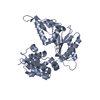
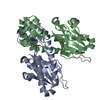
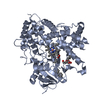

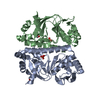
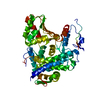
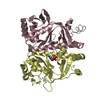
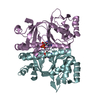


 PDBj
PDBj